Yunnan Province and its Strategic Significance in Southeast Asia
VerifiedAdded on 2022/09/05
|7
|1553
|20
Report
AI Summary
This report provides an in-depth analysis of the strategic significance of Yunnan Province to Southeast Asia. It explores Yunnan's geographical advantages, including its borders with several Southeast Asian countries, and its role as a crucial link between South Asia and Southeast Asia. The report examines the province's economic development, highlighting its key industries like electric power generation, tourism, and mining, and its involvement in regional initiatives such as the Greater Mekong Subregion project. It also discusses China's strategic positioning of Yunnan as a bridgehead for engaging with its neighbors, emphasizing the province's role in infrastructure development, trade, and investment flows. The report references various academic sources to support its arguments, providing a comprehensive overview of Yunnan's evolving role in the region.

Running head: YUNNAN PROVINCE AND ITS SIGNIFICANCE
Yunnan province and its significance
Name of the student:
Name of the university:
Author Note
Yunnan province and its significance
Name of the student:
Name of the university:
Author Note
Paraphrase This Document
Need a fresh take? Get an instant paraphrase of this document with our AI Paraphraser
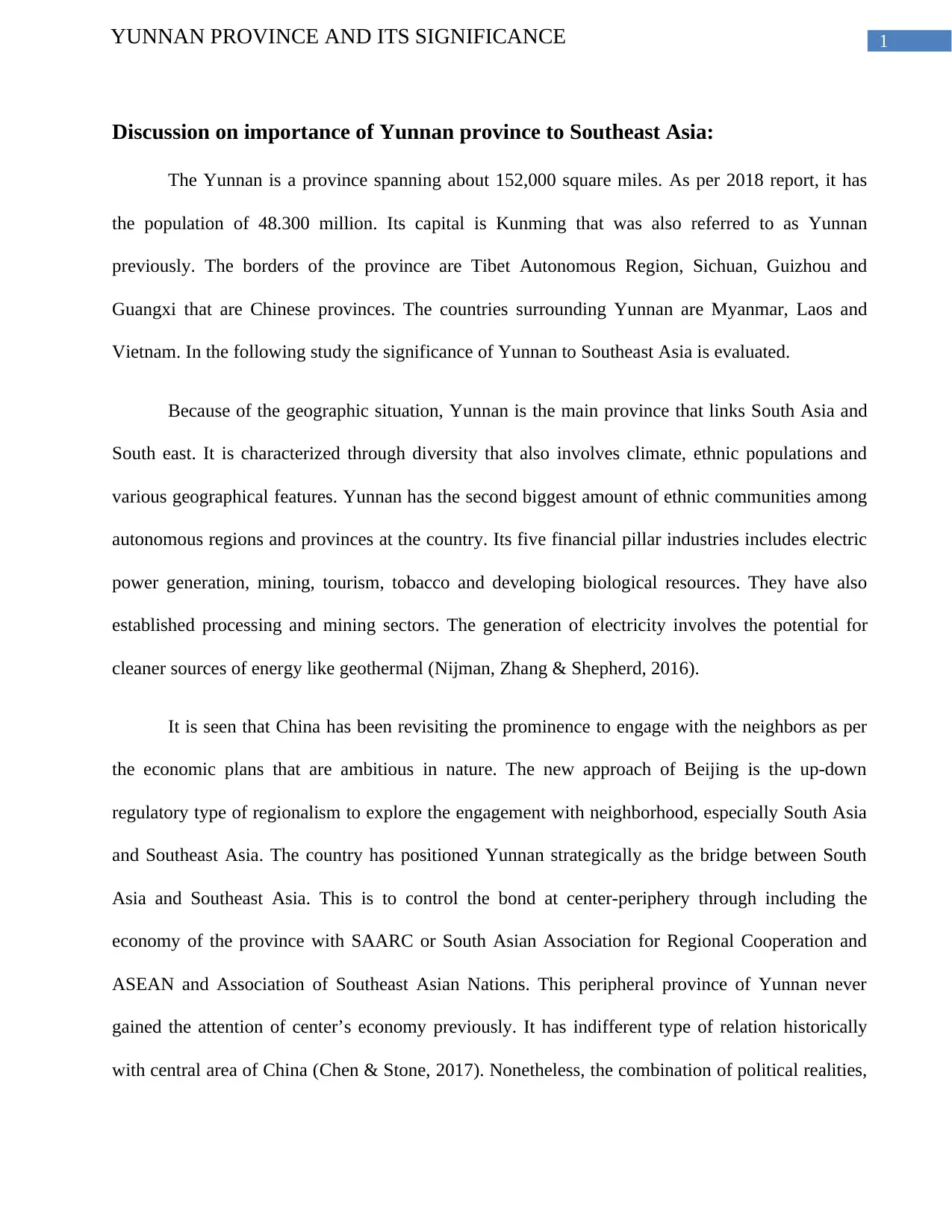
1YUNNAN PROVINCE AND ITS SIGNIFICANCE
Discussion on importance of Yunnan province to Southeast Asia:
The Yunnan is a province spanning about 152,000 square miles. As per 2018 report, it has
the population of 48.300 million. Its capital is Kunming that was also referred to as Yunnan
previously. The borders of the province are Tibet Autonomous Region, Sichuan, Guizhou and
Guangxi that are Chinese provinces. The countries surrounding Yunnan are Myanmar, Laos and
Vietnam. In the following study the significance of Yunnan to Southeast Asia is evaluated.
Because of the geographic situation, Yunnan is the main province that links South Asia and
South east. It is characterized through diversity that also involves climate, ethnic populations and
various geographical features. Yunnan has the second biggest amount of ethnic communities among
autonomous regions and provinces at the country. Its five financial pillar industries includes electric
power generation, mining, tourism, tobacco and developing biological resources. They have also
established processing and mining sectors. The generation of electricity involves the potential for
cleaner sources of energy like geothermal (Nijman, Zhang & Shepherd, 2016).
It is seen that China has been revisiting the prominence to engage with the neighbors as per
the economic plans that are ambitious in nature. The new approach of Beijing is the up-down
regulatory type of regionalism to explore the engagement with neighborhood, especially South Asia
and Southeast Asia. The country has positioned Yunnan strategically as the bridge between South
Asia and Southeast Asia. This is to control the bond at center-periphery through including the
economy of the province with SAARC or South Asian Association for Regional Cooperation and
ASEAN and Association of Southeast Asian Nations. This peripheral province of Yunnan never
gained the attention of center’s economy previously. It has indifferent type of relation historically
with central area of China (Chen & Stone, 2017). Nonetheless, the combination of political realities,
Discussion on importance of Yunnan province to Southeast Asia:
The Yunnan is a province spanning about 152,000 square miles. As per 2018 report, it has
the population of 48.300 million. Its capital is Kunming that was also referred to as Yunnan
previously. The borders of the province are Tibet Autonomous Region, Sichuan, Guizhou and
Guangxi that are Chinese provinces. The countries surrounding Yunnan are Myanmar, Laos and
Vietnam. In the following study the significance of Yunnan to Southeast Asia is evaluated.
Because of the geographic situation, Yunnan is the main province that links South Asia and
South east. It is characterized through diversity that also involves climate, ethnic populations and
various geographical features. Yunnan has the second biggest amount of ethnic communities among
autonomous regions and provinces at the country. Its five financial pillar industries includes electric
power generation, mining, tourism, tobacco and developing biological resources. They have also
established processing and mining sectors. The generation of electricity involves the potential for
cleaner sources of energy like geothermal (Nijman, Zhang & Shepherd, 2016).
It is seen that China has been revisiting the prominence to engage with the neighbors as per
the economic plans that are ambitious in nature. The new approach of Beijing is the up-down
regulatory type of regionalism to explore the engagement with neighborhood, especially South Asia
and Southeast Asia. The country has positioned Yunnan strategically as the bridge between South
Asia and Southeast Asia. This is to control the bond at center-periphery through including the
economy of the province with SAARC or South Asian Association for Regional Cooperation and
ASEAN and Association of Southeast Asian Nations. This peripheral province of Yunnan never
gained the attention of center’s economy previously. It has indifferent type of relation historically
with central area of China (Chen & Stone, 2017). Nonetheless, the combination of political realities,
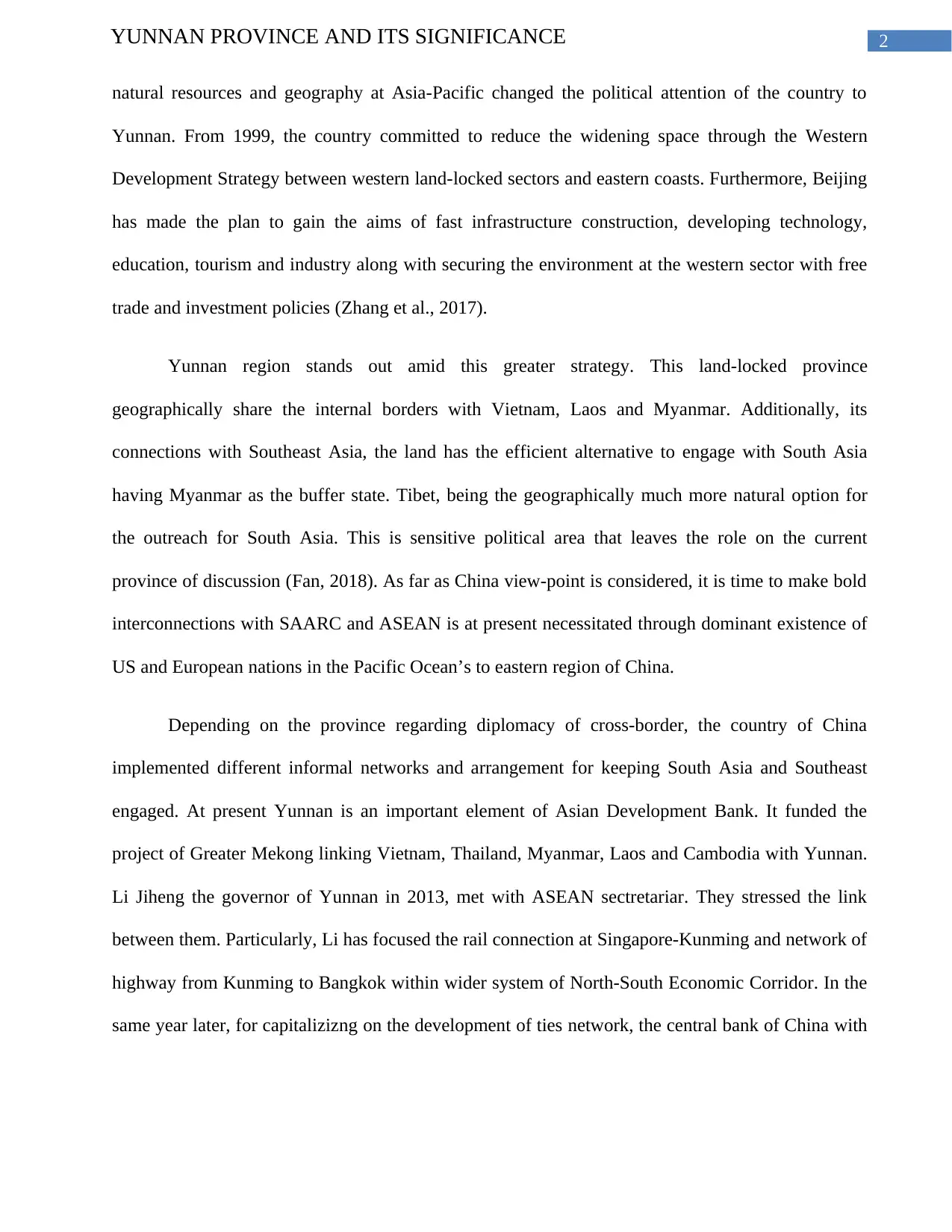
2YUNNAN PROVINCE AND ITS SIGNIFICANCE
natural resources and geography at Asia-Pacific changed the political attention of the country to
Yunnan. From 1999, the country committed to reduce the widening space through the Western
Development Strategy between western land-locked sectors and eastern coasts. Furthermore, Beijing
has made the plan to gain the aims of fast infrastructure construction, developing technology,
education, tourism and industry along with securing the environment at the western sector with free
trade and investment policies (Zhang et al., 2017).
Yunnan region stands out amid this greater strategy. This land-locked province
geographically share the internal borders with Vietnam, Laos and Myanmar. Additionally, its
connections with Southeast Asia, the land has the efficient alternative to engage with South Asia
having Myanmar as the buffer state. Tibet, being the geographically much more natural option for
the outreach for South Asia. This is sensitive political area that leaves the role on the current
province of discussion (Fan, 2018). As far as China view-point is considered, it is time to make bold
interconnections with SAARC and ASEAN is at present necessitated through dominant existence of
US and European nations in the Pacific Ocean’s to eastern region of China.
Depending on the province regarding diplomacy of cross-border, the country of China
implemented different informal networks and arrangement for keeping South Asia and Southeast
engaged. At present Yunnan is an important element of Asian Development Bank. It funded the
project of Greater Mekong linking Vietnam, Thailand, Myanmar, Laos and Cambodia with Yunnan.
Li Jiheng the governor of Yunnan in 2013, met with ASEAN sectretariar. They stressed the link
between them. Particularly, Li has focused the rail connection at Singapore-Kunming and network of
highway from Kunming to Bangkok within wider system of North-South Economic Corridor. In the
same year later, for capitalizizng on the development of ties network, the central bank of China with
natural resources and geography at Asia-Pacific changed the political attention of the country to
Yunnan. From 1999, the country committed to reduce the widening space through the Western
Development Strategy between western land-locked sectors and eastern coasts. Furthermore, Beijing
has made the plan to gain the aims of fast infrastructure construction, developing technology,
education, tourism and industry along with securing the environment at the western sector with free
trade and investment policies (Zhang et al., 2017).
Yunnan region stands out amid this greater strategy. This land-locked province
geographically share the internal borders with Vietnam, Laos and Myanmar. Additionally, its
connections with Southeast Asia, the land has the efficient alternative to engage with South Asia
having Myanmar as the buffer state. Tibet, being the geographically much more natural option for
the outreach for South Asia. This is sensitive political area that leaves the role on the current
province of discussion (Fan, 2018). As far as China view-point is considered, it is time to make bold
interconnections with SAARC and ASEAN is at present necessitated through dominant existence of
US and European nations in the Pacific Ocean’s to eastern region of China.
Depending on the province regarding diplomacy of cross-border, the country of China
implemented different informal networks and arrangement for keeping South Asia and Southeast
engaged. At present Yunnan is an important element of Asian Development Bank. It funded the
project of Greater Mekong linking Vietnam, Thailand, Myanmar, Laos and Cambodia with Yunnan.
Li Jiheng the governor of Yunnan in 2013, met with ASEAN sectretariar. They stressed the link
between them. Particularly, Li has focused the rail connection at Singapore-Kunming and network of
highway from Kunming to Bangkok within wider system of North-South Economic Corridor. In the
same year later, for capitalizizng on the development of ties network, the central bank of China with
⊘ This is a preview!⊘
Do you want full access?
Subscribe today to unlock all pages.

Trusted by 1+ million students worldwide
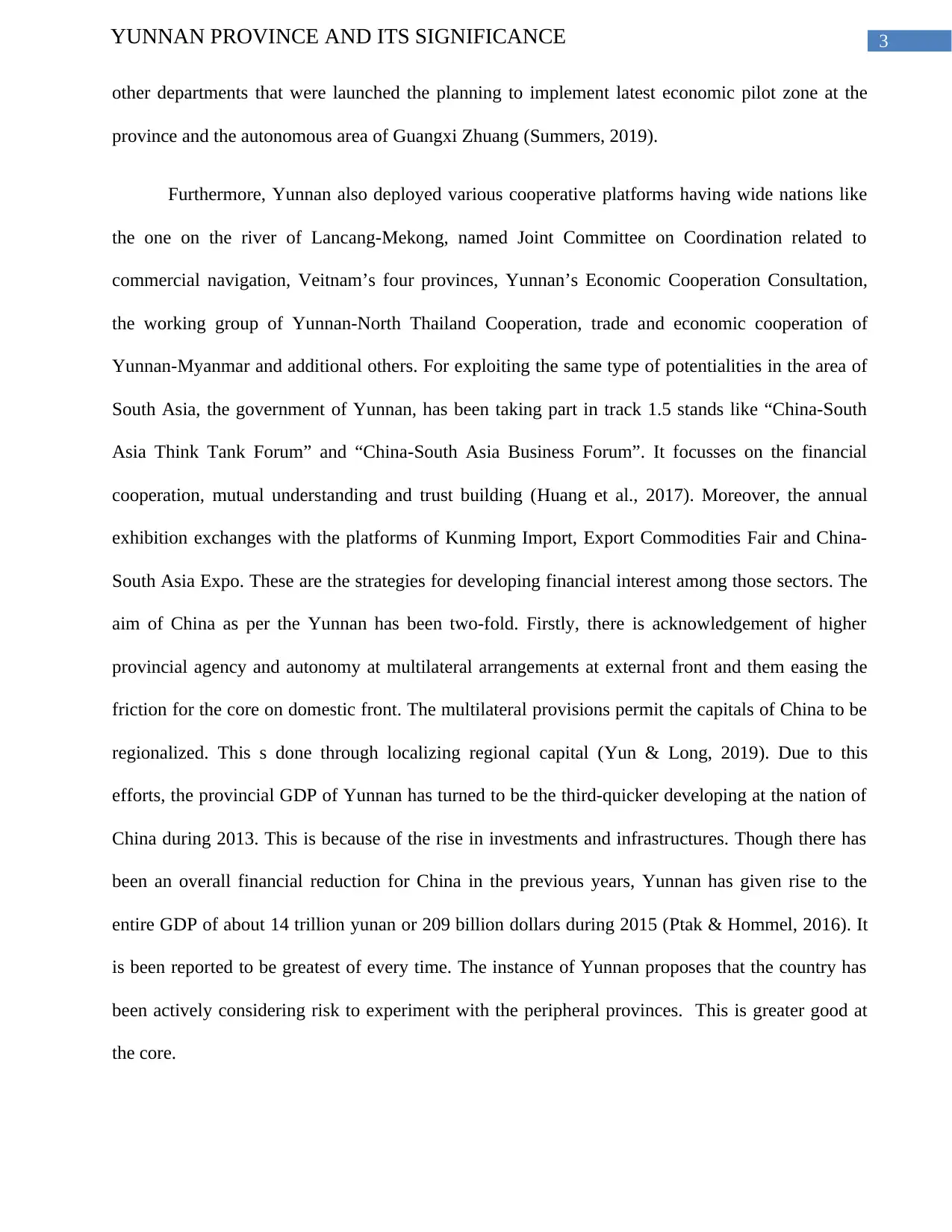
3YUNNAN PROVINCE AND ITS SIGNIFICANCE
other departments that were launched the planning to implement latest economic pilot zone at the
province and the autonomous area of Guangxi Zhuang (Summers, 2019).
Furthermore, Yunnan also deployed various cooperative platforms having wide nations like
the one on the river of Lancang-Mekong, named Joint Committee on Coordination related to
commercial navigation, Veitnam’s four provinces, Yunnan’s Economic Cooperation Consultation,
the working group of Yunnan-North Thailand Cooperation, trade and economic cooperation of
Yunnan-Myanmar and additional others. For exploiting the same type of potentialities in the area of
South Asia, the government of Yunnan, has been taking part in track 1.5 stands like “China-South
Asia Think Tank Forum” and “China-South Asia Business Forum”. It focusses on the financial
cooperation, mutual understanding and trust building (Huang et al., 2017). Moreover, the annual
exhibition exchanges with the platforms of Kunming Import, Export Commodities Fair and China-
South Asia Expo. These are the strategies for developing financial interest among those sectors. The
aim of China as per the Yunnan has been two-fold. Firstly, there is acknowledgement of higher
provincial agency and autonomy at multilateral arrangements at external front and them easing the
friction for the core on domestic front. The multilateral provisions permit the capitals of China to be
regionalized. This s done through localizing regional capital (Yun & Long, 2019). Due to this
efforts, the provincial GDP of Yunnan has turned to be the third-quicker developing at the nation of
China during 2013. This is because of the rise in investments and infrastructures. Though there has
been an overall financial reduction for China in the previous years, Yunnan has given rise to the
entire GDP of about 14 trillion yunan or 209 billion dollars during 2015 (Ptak & Hommel, 2016). It
is been reported to be greatest of every time. The instance of Yunnan proposes that the country has
been actively considering risk to experiment with the peripheral provinces. This is greater good at
the core.
other departments that were launched the planning to implement latest economic pilot zone at the
province and the autonomous area of Guangxi Zhuang (Summers, 2019).
Furthermore, Yunnan also deployed various cooperative platforms having wide nations like
the one on the river of Lancang-Mekong, named Joint Committee on Coordination related to
commercial navigation, Veitnam’s four provinces, Yunnan’s Economic Cooperation Consultation,
the working group of Yunnan-North Thailand Cooperation, trade and economic cooperation of
Yunnan-Myanmar and additional others. For exploiting the same type of potentialities in the area of
South Asia, the government of Yunnan, has been taking part in track 1.5 stands like “China-South
Asia Think Tank Forum” and “China-South Asia Business Forum”. It focusses on the financial
cooperation, mutual understanding and trust building (Huang et al., 2017). Moreover, the annual
exhibition exchanges with the platforms of Kunming Import, Export Commodities Fair and China-
South Asia Expo. These are the strategies for developing financial interest among those sectors. The
aim of China as per the Yunnan has been two-fold. Firstly, there is acknowledgement of higher
provincial agency and autonomy at multilateral arrangements at external front and them easing the
friction for the core on domestic front. The multilateral provisions permit the capitals of China to be
regionalized. This s done through localizing regional capital (Yun & Long, 2019). Due to this
efforts, the provincial GDP of Yunnan has turned to be the third-quicker developing at the nation of
China during 2013. This is because of the rise in investments and infrastructures. Though there has
been an overall financial reduction for China in the previous years, Yunnan has given rise to the
entire GDP of about 14 trillion yunan or 209 billion dollars during 2015 (Ptak & Hommel, 2016). It
is been reported to be greatest of every time. The instance of Yunnan proposes that the country has
been actively considering risk to experiment with the peripheral provinces. This is greater good at
the core.
Paraphrase This Document
Need a fresh take? Get an instant paraphrase of this document with our AI Paraphraser
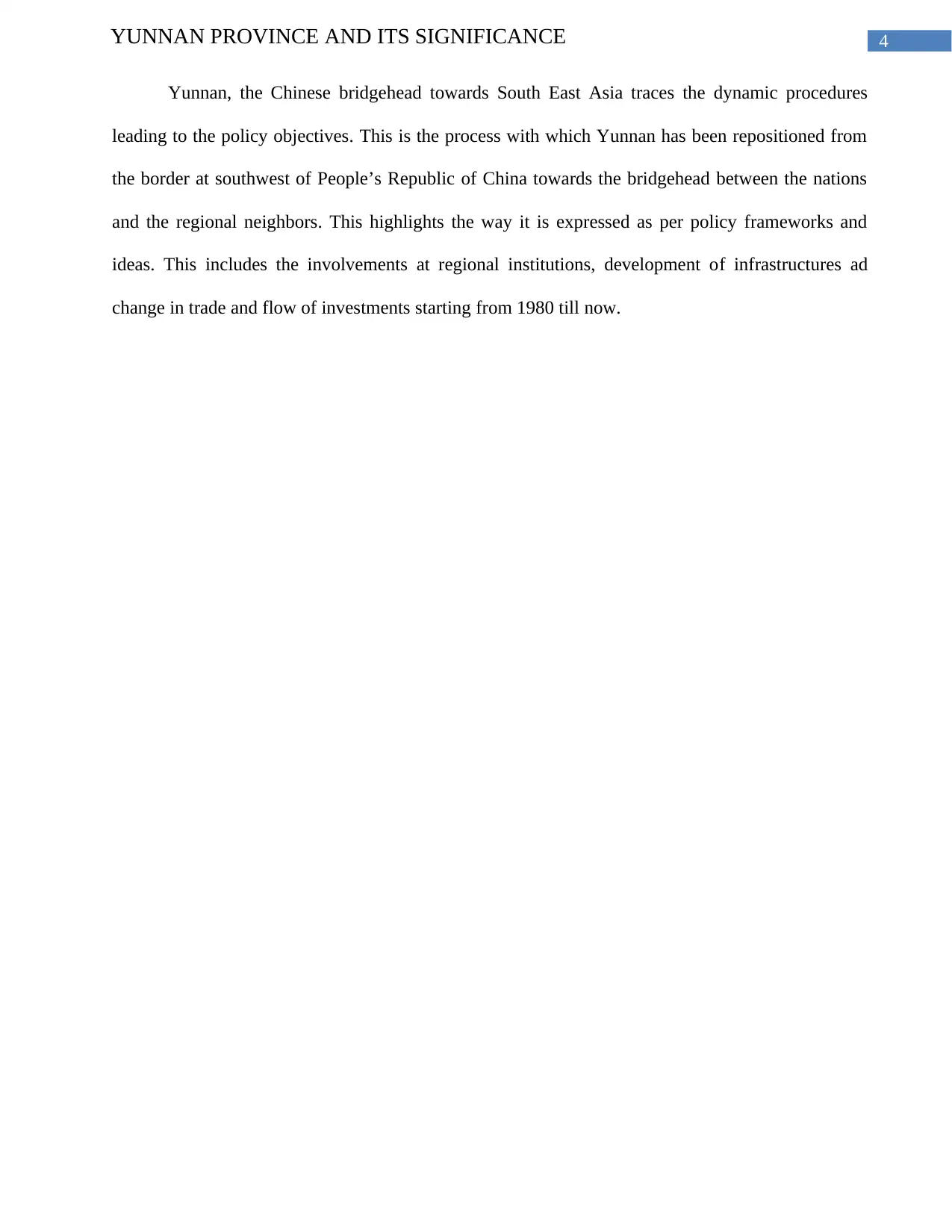
4YUNNAN PROVINCE AND ITS SIGNIFICANCE
Yunnan, the Chinese bridgehead towards South East Asia traces the dynamic procedures
leading to the policy objectives. This is the process with which Yunnan has been repositioned from
the border at southwest of People’s Republic of China towards the bridgehead between the nations
and the regional neighbors. This highlights the way it is expressed as per policy frameworks and
ideas. This includes the involvements at regional institutions, development of infrastructures ad
change in trade and flow of investments starting from 1980 till now.
Yunnan, the Chinese bridgehead towards South East Asia traces the dynamic procedures
leading to the policy objectives. This is the process with which Yunnan has been repositioned from
the border at southwest of People’s Republic of China towards the bridgehead between the nations
and the regional neighbors. This highlights the way it is expressed as per policy frameworks and
ideas. This includes the involvements at regional institutions, development of infrastructures ad
change in trade and flow of investments starting from 1980 till now.
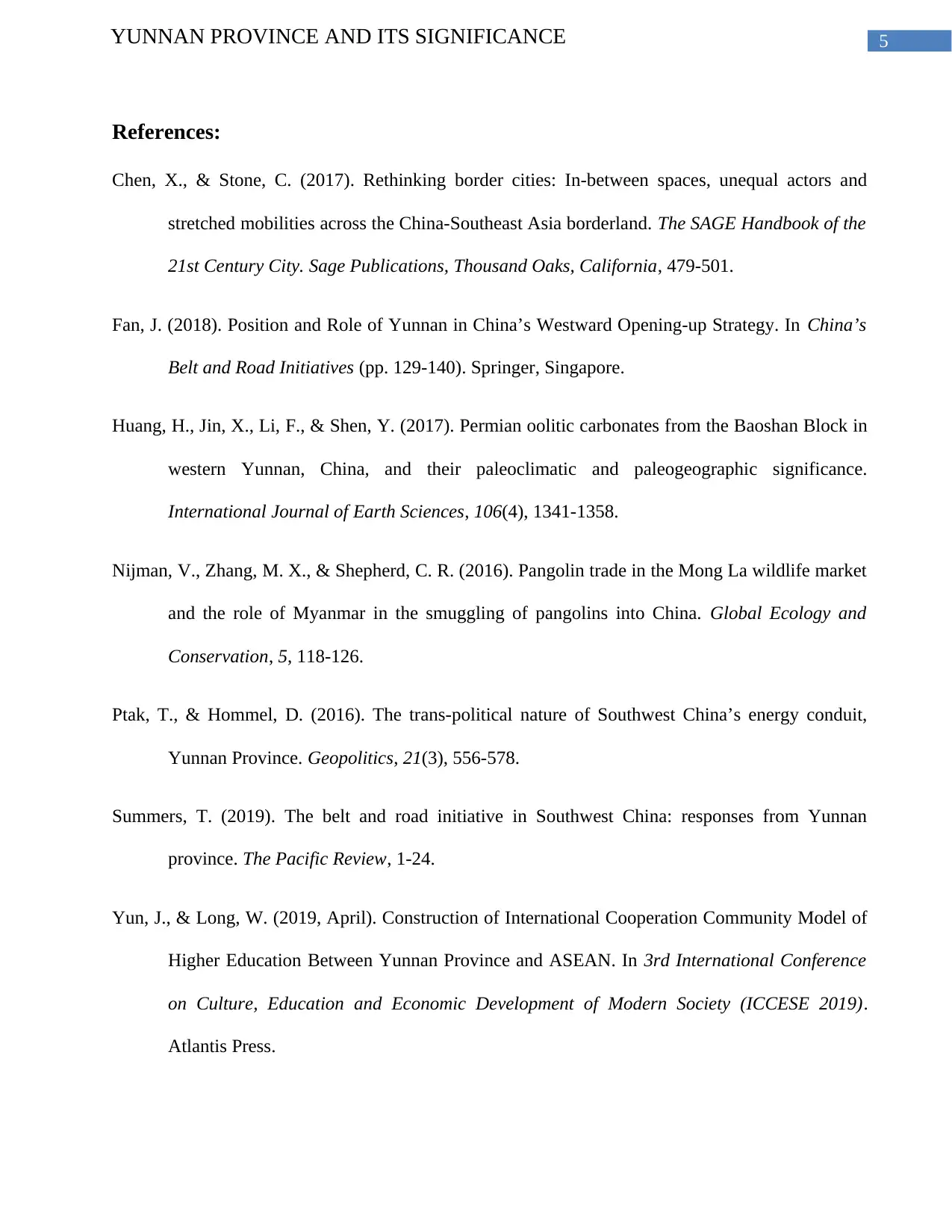
5YUNNAN PROVINCE AND ITS SIGNIFICANCE
References:
Chen, X., & Stone, C. (2017). Rethinking border cities: In-between spaces, unequal actors and
stretched mobilities across the China-Southeast Asia borderland. The SAGE Handbook of the
21st Century City. Sage Publications, Thousand Oaks, California, 479-501.
Fan, J. (2018). Position and Role of Yunnan in China’s Westward Opening-up Strategy. In China’s
Belt and Road Initiatives (pp. 129-140). Springer, Singapore.
Huang, H., Jin, X., Li, F., & Shen, Y. (2017). Permian oolitic carbonates from the Baoshan Block in
western Yunnan, China, and their paleoclimatic and paleogeographic significance.
International Journal of Earth Sciences, 106(4), 1341-1358.
Nijman, V., Zhang, M. X., & Shepherd, C. R. (2016). Pangolin trade in the Mong La wildlife market
and the role of Myanmar in the smuggling of pangolins into China. Global Ecology and
Conservation, 5, 118-126.
Ptak, T., & Hommel, D. (2016). The trans-political nature of Southwest China’s energy conduit,
Yunnan Province. Geopolitics, 21(3), 556-578.
Summers, T. (2019). The belt and road initiative in Southwest China: responses from Yunnan
province. The Pacific Review, 1-24.
Yun, J., & Long, W. (2019, April). Construction of International Cooperation Community Model of
Higher Education Between Yunnan Province and ASEAN. In 3rd International Conference
on Culture, Education and Economic Development of Modern Society (ICCESE 2019).
Atlantis Press.
References:
Chen, X., & Stone, C. (2017). Rethinking border cities: In-between spaces, unequal actors and
stretched mobilities across the China-Southeast Asia borderland. The SAGE Handbook of the
21st Century City. Sage Publications, Thousand Oaks, California, 479-501.
Fan, J. (2018). Position and Role of Yunnan in China’s Westward Opening-up Strategy. In China’s
Belt and Road Initiatives (pp. 129-140). Springer, Singapore.
Huang, H., Jin, X., Li, F., & Shen, Y. (2017). Permian oolitic carbonates from the Baoshan Block in
western Yunnan, China, and their paleoclimatic and paleogeographic significance.
International Journal of Earth Sciences, 106(4), 1341-1358.
Nijman, V., Zhang, M. X., & Shepherd, C. R. (2016). Pangolin trade in the Mong La wildlife market
and the role of Myanmar in the smuggling of pangolins into China. Global Ecology and
Conservation, 5, 118-126.
Ptak, T., & Hommel, D. (2016). The trans-political nature of Southwest China’s energy conduit,
Yunnan Province. Geopolitics, 21(3), 556-578.
Summers, T. (2019). The belt and road initiative in Southwest China: responses from Yunnan
province. The Pacific Review, 1-24.
Yun, J., & Long, W. (2019, April). Construction of International Cooperation Community Model of
Higher Education Between Yunnan Province and ASEAN. In 3rd International Conference
on Culture, Education and Economic Development of Modern Society (ICCESE 2019).
Atlantis Press.
⊘ This is a preview!⊘
Do you want full access?
Subscribe today to unlock all pages.

Trusted by 1+ million students worldwide

6YUNNAN PROVINCE AND ITS SIGNIFICANCE
Zhang, Y., Vrancken, B., Feng, Y., Dellicour, S., Yang, Q., Yang, W., ... & Tian, H. (2017). Cross-
border spread, lineage displacement and evolutionary rate estimation of rabies virus in
Yunnan Province, China. Virology journal, 14(1), 102.
Zhang, Y., Vrancken, B., Feng, Y., Dellicour, S., Yang, Q., Yang, W., ... & Tian, H. (2017). Cross-
border spread, lineage displacement and evolutionary rate estimation of rabies virus in
Yunnan Province, China. Virology journal, 14(1), 102.
1 out of 7
Your All-in-One AI-Powered Toolkit for Academic Success.
+13062052269
info@desklib.com
Available 24*7 on WhatsApp / Email
![[object Object]](/_next/static/media/star-bottom.7253800d.svg)
Unlock your academic potential
Copyright © 2020–2025 A2Z Services. All Rights Reserved. Developed and managed by ZUCOL.


